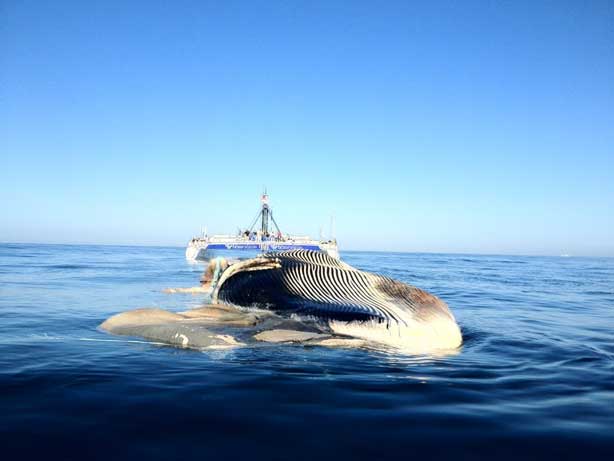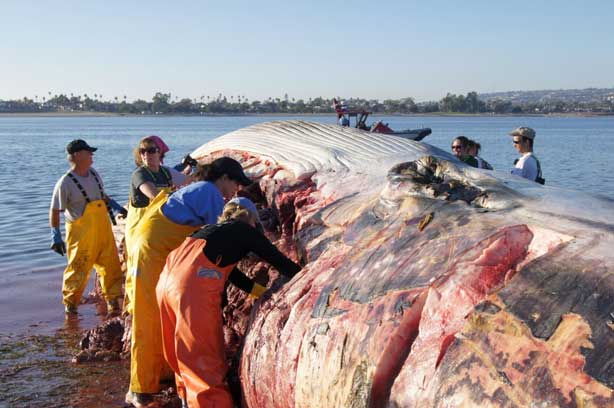A new and interesting area of scientific research is called a “whale fall”. This occurs when a whale dies and the massive body falls to the ocean floor. During the fall and for many months afterwards the whale becomes a haven for life.
This process, first observed in 1987, revealed 30 previously unknown species and has since become a popular research focus. Imagine an entire school bus gradually sinking and then resting on the ocean floor. Whole species thrive off of nutrient-rich area and some, including the newly discovered species, live solely on the school bus (whale carcass).
This burgeoning area of research recently received a lucky gift, actually several of them. The story starts on a San Diego beach:
The 67-foot fin whale was towed to Fiesta Island on Nov. 23 for scientific study. When the carcass landed on the water line, about two dozen researchers started carving it up for biological samples.
Scientists quickly determined that the whale had been killed by a ship because it had numerous fractured vertebrae and large areas of hemorrhage that indicated that it was alive when hit, according to a report put together by Kisfaludy and his partners at the National Oceanic and Atmospheric Administration, SeaWorld and Scripps Institution of Oceanography.
Then city officials, unsure what to do with this massive thing, “announced plans to haul the whale to a landfill,” and that’s when Virgin Oceanic got involved. They offered to tow it out to sea using their crew and 125-foot catamaran.
The organization, one of Richard Branson’s enterprises, promotes exploration of the seas. Its leaders wanted to see the carcass turned into an undersea laboratory.
For two nights, the whale was secured to a telephone pole by heavy rope and to an anchor in Mission Bay.
The day after the necropsy — Thanksgiving — Kisfaludy said he and Rouse “ran all over the county looking for steel that we could use.” They found 3,000 pounds of large shackles and 13 links of large ship chain that totaled about 1,000 pounds. They added that to 10,200 pounds of rusty steel mooring weights Kisfaludy secured from sources at Newport Harbor, where Virgin’s 125-foot catamaran docks.
The recreational catamaran then towed the whale 11 miles out to sea and released it. It sat there for a moment until it got crushed by a wave and then sank 800 meters to the ocean floor.
In the coming months Scripps researchers plan to visit the carcass using Remotely Operated Vehicles in search of new biological discoveries.
More:
Whale photos from San Diego Union-Tribune
Video of a whale fall, just landed and 18 months later

